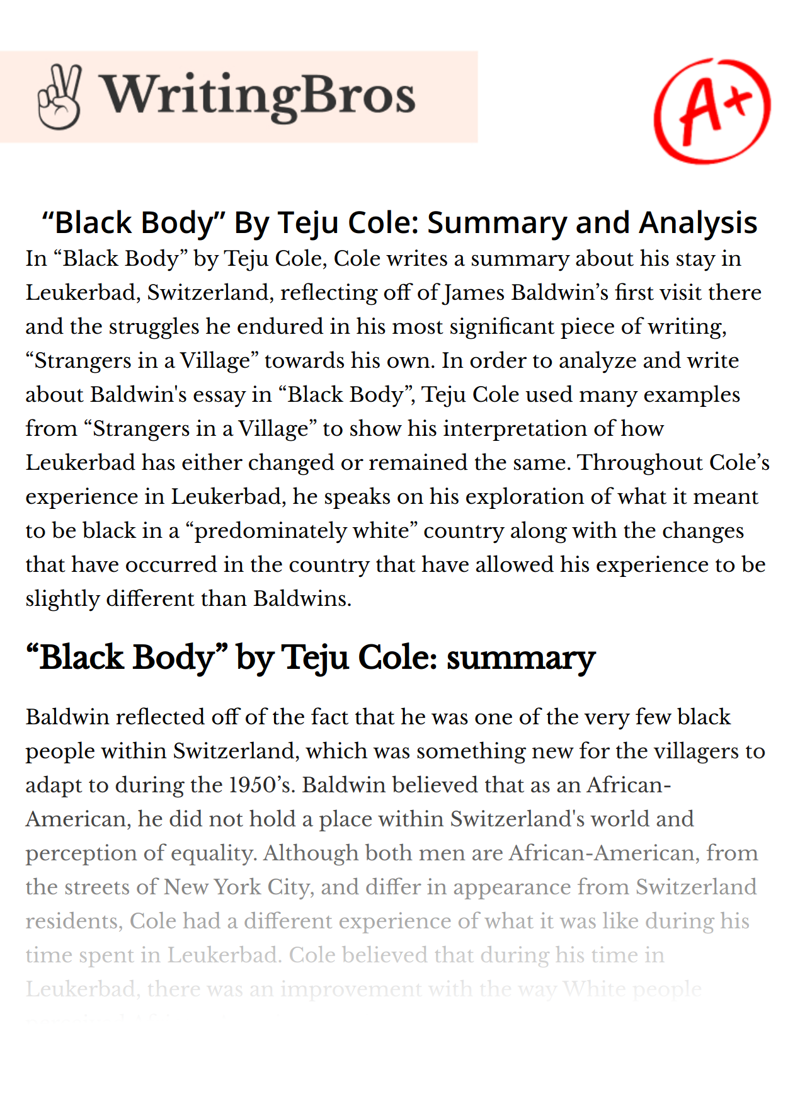“Black Body” By Teju Cole: Summary and Analysis

In “Black Body” by Teju Cole, Cole writes a summary about his stay in Leukerbad, Switzerland, reflecting off of James Baldwin’s first visit there and the struggles he endured in his most significant piece of writing, “Strangers in a Village” towards his own. In order to analyze and write about Baldwin's essay in “Black Body”, Teju Cole used many examples from “Strangers in a Village” to show his interpretation of how Leukerbad has either changed or remained the same. Throughout Cole’s experience in Leukerbad, he speaks on his exploration of what it meant to be black in a “predominately white” country along with the changes that have occurred in the country that have allowed his experience to be slightly different than Baldwins.
“Black Body” by Teju Cole: summary
Baldwin reflected off of the fact that he was one of the very few black people within Switzerland, which was something new for the villagers to adapt to during the 1950’s. Baldwin believed that as an African-American, he did not hold a place within Switzerland's world and perception of equality. Although both men are African-American, from the streets of New York City, and differ in appearance from Switzerland residents, Cole had a different experience of what it was like during his time spent in Leukerbad. Cole believed that during his time in Leukerbad, there was an improvement with the way White people perceived African-Americans and other races, allowing them to hold a part within their society. Cole states, “At a pizzeria, a table of British tourist stares at me. But the waitress was part black, and at the hotel one of the staff members at the spa was an older black man… my not being the only black person in the village is the plain fact that many other people I saw were also foreigners, This was the biggest change of all”. Compared to Baldwin being one of the only African-American men while in Switzerland, the country has shown gradual improvement in accepting individuals of other races, allowing them to be a part of their working class in the village. Another example of where the two men’s perceptions differ is on Page Eleven when Cold states, “This is where I part ways with Baldwin. I disagree not with his particular sorrow but with the self-abnegation that pinned him to it… I can oppose white supremacy and still rejoice in Gothic architecture”. Baldwin believed the artwork he viewed while visiting museums did not go hand in hand with his heritage while Cole felt a sense of acceptance and belonging while viewing the images, and appreciated the fact that White people had an understanding of African-American culture. While walking in the streets of Switzerland, Cole would often be looked at by others. He states, “I wasn’t a remarkable light… The test is how long the glances last, whether they become stares, with what intent they occur… To be a stranger is to be looked at, but to be a black is to be looked at especially”. Cole did not expect to show up in Switzerland and be portrayed as one of their own. He was aware of the fact that he would be viewed differently based on Baldwin's essay, but he took the looks and stares kind-heartedly due to his understanding of Switzerland still adapting to the integration of many new races. Lastly, Cole brings up Baldwins words, “People are trapped in history, and history is trapped in them”. Cole refutes Baldwins’ claim and believes that overtime the world has gone through many significant changes and “History is now and black America”. While in Switzerland, Cole has interacted and seen people of other races such as African-Americans and Asians, mixed within the well-known White populated Swiss village. Cole notes on Page Six that in Swiss clubs and local restaurants, African-American artist’s songs are played such as Whitney Houston, Meek Mill, Beyonce and Drake. This displays the integration of African-American culture in Switzerland and how people are becoming acceptive towards genres of music created by people of other races.
“Black Body” allows Cole to show that even in a small country like Switzerland, it is very much possible for acceptance towards diversity rates to increase and for people to accept the ability of change. Baldwin and Cole both seeked different interpretations of what it meant to be an African-American man due to how much the country has changed from 1953 to 2014. In the 1950’s, African-American culture was not appreciated in Switzerland or anywhere throughout the world due to how African-Americans differentiated in many ways from physical and cultural aspects. As for Cole, African-American culture has elevated and became more accepted by others during his time of living due to the immense amount of unique races spread all throughout the world and shared perceptions of equality for all races.
References
- Cole, T. (2016). Known and Strange Things. Random House.
- Cole, T. (2012). Black Body: Rereading James Baldwin's “Stranger in the Village”. The New Yorker. https://www.newyorker.com/books/page-turner/black-body-rereading-james-baldwins-stranger-in-the-village
- Fitch, N. (2018). Black Body: A Memoir of Race and Memory. Urban Omnibus. https://urbanomnibus.net/2018/02/black-body-a-memoir-of-race-and-memory/
- Henderson, A. (2015). Teju Cole's "Black Body" and the Limits of Empathy. African American Review, 48(4), 415-428. https://doi.org/10.1353/afa.2015.0050
- Jenkins, N. (2017). The Aesthetics of Memory in Teju Cole’s Black Body. Critique: Studies in Contemporary Fiction, 58(2), 156-164. https://doi.org/10.1080/00111619.2016.1191934
- Matz, J. (2016). A Long Way Gone: Memory, Time, and Justice in Teju Cole's Black Body. Criticism, 58(1), 39-61. https://doi.org/10.13110/criticism.58.1.0039
- Miller, D. A. (2016). Black Body in the Shadow Archive: Teju Cole and James Baldwin. Criticism, 58(1), 19-38. https://doi.org/10.13110/criticism.58.1.0019
- Mukherjee, R. (2017). Black Body: The Aesthetics of Race and Memory in Teju Cole's Known and Strange Things. Journal of Postcolonial Writing, 53(4), 510-521. https://doi.org/10.1080/17449855.2017.1299311
- Reid-Pharr, R. (2017). On Teju Cole's "Black Body". Critical Inquiry, 43(2), 482-486. https://doi.org/10.1086/690976
Cite this Essay
To export a reference to this article please select a referencing style below

